Dukes of Brittany family tree on:
[Wikipedia]
[Google]
[Amazon]
This is a list of rulers of the
the Fox
(''Alan al Louarn'')
938–952 , , before 919
son of Mathuedoi, Count of Poher, and a daughter of Alan I , (1) Roscille of Anjou
943
(2) ? of Blois
bef. 949/51
one son , 952
Nantes
aged about 33 , - , width=auto, Drogo
(''Drogon'')
952–958 , , 949/52
only legitimate son of Alan II , ''never married'' , 958
aged 5–9 , - , width=auto, Hoël I
(''Hoel Iañ '')
958–981 , , ?
illegitimate son of Alan II and the "noble" Judith , ''never married'' , 981
, - , width=auto, Guerech
(''Guerech Iañ'')
981–988 , , ?
illegitimate son of Alan II and the "noble" Judith, younger brother of Hoël I , Aremburga of Ancenis
after 981
one son , 988
, - , width=auto, Alan
(''Alan Breizh'')
988–990 , , after 981
son of Guerech and Aremburga of Ancenis , ''never married'' , 990 , -
(''Konan Iañ'')
990–992 , , 927
eldest son of Judicael Berengar, Count of Rennes and Gerberga , Ermengarde-Gerberga of Anjou
973
five children , 27 June 992
Conquereuil
aged 64–65 , - , width=auto, Geoffrey I
(''Jafrez Iañ '')
992–1008 , , 980
eldest son of Conan I and Ermengarde-Gerberga of Anjou , Hawise of Normandy
996
four children , 20 November 1008
aged 27–28 , - , width=auto, Alan III
(''Alan III'')
1008–1040
''with Odo I as regent, then co-ruler (1008–1034)'' , , 997
, 997
eldest son of Geoffrey I and Hawise of Normandy , Bertha of Blois
1018
two children , 1 October 1040
Montgommery
aged 42–43 , - , width=auto, Odo I
(''Eozen I'')
1008–1034
''as regent, then co-ruler to Alan III'' , , 999
, 999
second son of Geoffrey I and Hawise of Normandy , Orguen of Cornouaille
six children , 1079
aged 79–80 , - , width=auto, Conan II
(''Konan II'')
1040–1066
''with Odo I as regent (1040–1057)'' , , 1033
only son of Alan III and Bertha of Blois , ''never married'' , 11 December 1066
aged 32–33 , - , width=auto, Hawise
(''Hawiz'')
1066–1072
''with Hoël II '' , , 1037
only daughter of Alan III and Bertha of Blois , rowspan="2", 1066
seven children , 19 August 1072
aged 34–35 , - , width=auto, Hoël II
(''Hoël II'')
1066–1072
''with Hawise '' , , 1031
eldest son of Alain Canhiart, Count of Cornouaille and Judith of Nantes, descendant of Alan II , 13 April 1084
aged 52–53 , -
the Younger
(''Alan IV Fergant '')
1072–1112
''with Hoël II as regent
(1072–1084)'' , , bef. 1060
, bef. 1060
eldest son of Hoël II and Hawise , (1)
1086/88
no issue
(2) Ermengarde of Anjou
1093
three children , 13 October 1119
Redon Abbey
aged 60s , - , width=auto, Conan III
the Fat
(''Konan III'')
1112–1148 , , 1093–1096
, 1093–1096
eldest son of Alan IV and Ermengarde of Anjou , Maud FitzRoy
1112
three children , 17 September 1148
aged 54–58 , - , width=auto,
(''Berta'')
1148–1156
''with Odo II '' , , 1114
, 1114
eldest daughter of Conan III and Maud FitzRoy , (1) Alan, 1st Earl of Richmond
1137/8
three children
(2) Odo II
1148
three children , 1156
aged 41–43 , - , width=auto, Odo II
(''Eozen II'')
1148–1156
''with , ?
, ?
eldest son of Geoffrey, Viscount of Porhoet and Hawise , (1)
1148
three children
(2) Joan-Eleanor of Léon
August 1167
two or three children , 1170
, -
, width=auto, Conan IV the Black
(''Konan IV'')
1156–1166 , , 1138
, 1138
only son of Alan of Penthièvre, 1st Earl of Richmond and
1160
one daughter , 20 February 1171
aged 33 , - , width=auto, Constance
(''Konstanza'')
1166–1201
''with Geoffrey II
(1181–1186)
with
(1196–1201)
with Guy
(1199–1201)'' , , 1161
, 1161
daughter of Conan IV and Margaret of Huntingdon , (1) Geoffrey II
July 1181
three children
(2) Ranulf
3 February 1188
no issue
(3)
October 1199
two or three daughters , 5 September 1201
Nantes
aged 40 , - , width=auto, Geoffrey II
(''Jafrez II'')
1181–1186
''with Constance '' , , 23 September 1158
, 23 September 1158
fourth son of
July 1181
three children , 19 August 1186
Paris, France
aged 27 , - , width=auto, Guy
(''Gi'')
1199–1201
1203–1213''
with Constance
(1199–1201)
with Alix
(1203–1213)'' , , birth date unknown
second son of
October 1199
two or three daughters
(2) Eustachie of Chemillé
1203
two sons , 13 April 1213
Chemillé, France , -
, width=auto,
(''Arzhur Iañ'')
1196–1203
''with Constance
(1196–1201)'' , , 29 March 1187
, 29 March 1187
in Nantes,
only son of Geoffrey II and Constance , never married , Disappeared in captivity aged 16; fate unknown , -
(''Alis'')
1203–1221
''with Guy as regent
(1203–1213)
with Peter I
(1213–1221)'' ,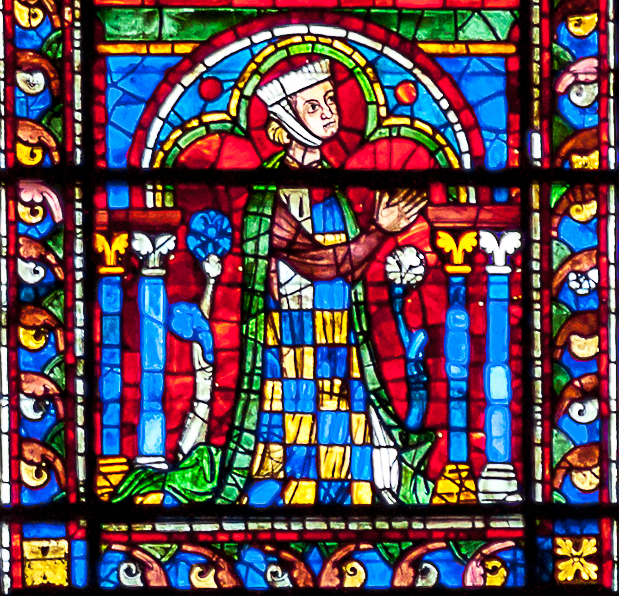 , 1200
, 1200
eldest daughter of Guy and Constance , Peter I
1213
three children , 21 October 1221
aged 21 , - , width=auto, Peter I
Mauclerc
(''Pêr Iañ'')
1213–1221
''with Alix'' ,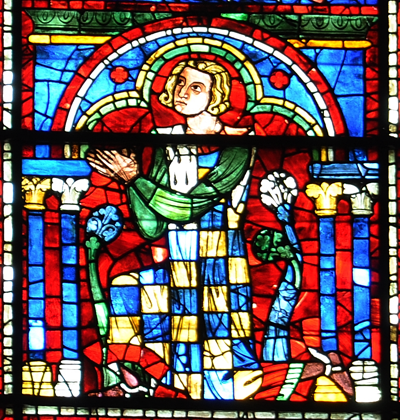 , 1190
, 1190
second son of Robert II of Dreux and
1213
three children
(2) Nicole
1230
one son
(3)
bef. January 1236
no issue , 6 July 1250
sea off
aged 59–60 , -
, width=auto, John I
the Red
(''Yann Iañ ar Ruz'')
1221–1286
''with Peter I as regent
(1221–1237)'' , , 1217/18
, 1217/18
eldest son of Peter I and Alix , Blanche of Navarre
Château-Thierry, Aisne
16 January 1236
eight children , 8 October 1286
Château de l'Isle, Férel,
aged 67–69 , - , width=auto, John II
(''Yann II'')
1286–1305 ,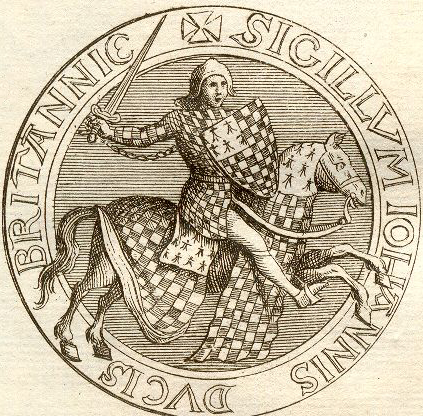 , 3/4 January 1239
, 3/4 January 1239
eldest son of John I and Blanche of Navarre , Beatrice of England
25 December 1260
eight children , 16 November 1305
aged 66 , - , width=auto, Arthur II
(''Arzhur II'')
1305–1312 ,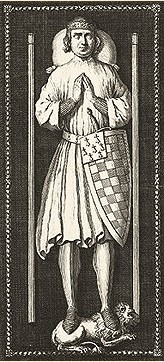 , 2 July 1262
, 2 July 1262
eldest son of John II and Beatrice of England , (1) Marie of Limoges
1277
three children
(2) Yolande of Dreux
May 1292
six children , 27 August 1312
Château de l'Isle, Férel,
aged 50 , - , width=auto, John III
the Good
(''Yann III'')
1312–1341 ,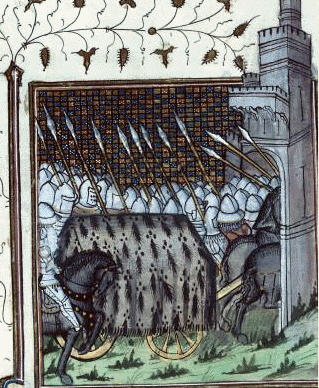 , 8 March 1286
, 8 March 1286
Château de Champtoceaux, Maine-et-Loire
eldest son of Arthur II and Marie of Limoges , (1)
18 February 1298
no issue
(2) Isabella of Castile and León
21 June 1310
no issue
(3) Joan of Savoy
Chartres
21 March 1330
no issue , 30 April 1341
Caen
aged 55
the Lame
(''Janed'')
1341–1364
''with Charles I '' ,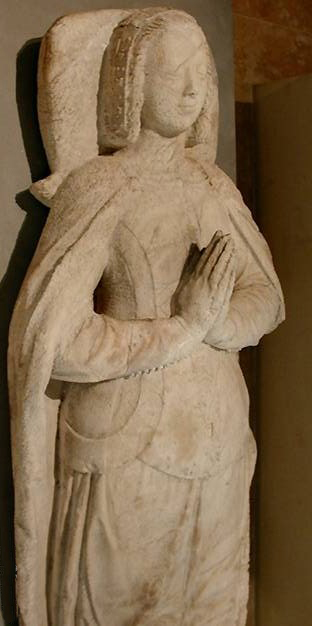 , 1319
, 1319
only daughter of Guy of Brittany, Count of Penthièvre and Joan of Avaugour , rowspan="2", Paris
4 June 1337
five children , 10 September 1384
aged 64–65 , - , width=auto, Charles I
(''Charlez Iañ'')
1341–1364
''with Joan '' , , 1319
, 1319
second son of Guy I, Count of Blois and
Auray
aged 44–45 , - , width=auto, John (IV) of Montfort
(''Yann IV Moñforzh'')
May 1341–1345 , , 1293
, 1293
only son of Arthur II and Yolande de Dreux , Joanna of Flanders
Chartres
March 1329
two children , 26 September 1345
Château d'Hennebon,
aged 51–52 , - , width=auto, John (V) of Montfort
(''Yann V Moñforzh'')
1345–1364 ,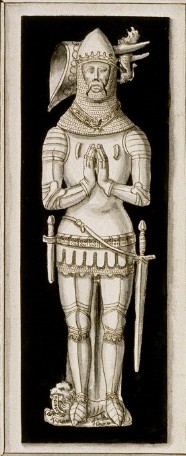 , 1339
, 1339
only son of John of Montfort and Joanna of Flanders , (1) Mary Plantagenet of England
summer of 1361
no issue
(2) Joan Holland
London
May 1366
no issue
(3)
Saillé-près-Guérande
2 October 1386
nine children , 1/2 November 1399
Nantes
aged 59–60
the Conqueror
(''Yann IV'')
1364–1399
(Previously ''John V'' in pretentious succession from his father.) , , 1339
, 1339
only son of John of Montfort and Joanna of Flanders , (1) Mary Plantagenet of England
summer of 1361
no issue
(2) Joan Holland
London
May 1366
no issue
(3)
Saillé-près-Guérande
2 October 1386
nine children , 1/2 November 1399
Nantes
aged 59–60 , - , width=auto, John V
the Wise
(''Yann V ar Fur'')
1399–1442 , , 24 December 1389
, 24 December 1389
Château de l'Hermine, Vannes,
eldest son of John IV and
Hôtel de Saint-Pol, Paris
19 September 1396
seven children , 29 August 1442
Manoir de La Touche, Nantes
aged 52 , - , width=auto, Francis I
the Well-Loved
(''Frañsez Iañ'')
1442–1450 , , 11 May 1414
, 11 May 1414
Vannes
eldest son of John V and Joan of France , (1) Yolande of Anjou
Amboise
20 August 1431
one son
(2) Isabella of Scotland
Château d'Auray
30 October 1442
two daughter , 17 July 1450
Château de l'Hermine, Vannes,
aged 36 , - , width=auto, Peter II
the Simple
(''Pêr II'')
1450–1457 , , 7 July 1418
, 7 July 1418
Nantes
second son of John V and Joan of France , Françoise d'Amboise
1442
no issue , 22 September 1457
Nantes
aged 41 , - , width=auto, Arthur III
the Justicier
(''Arzhur III'')
1457–1458 ,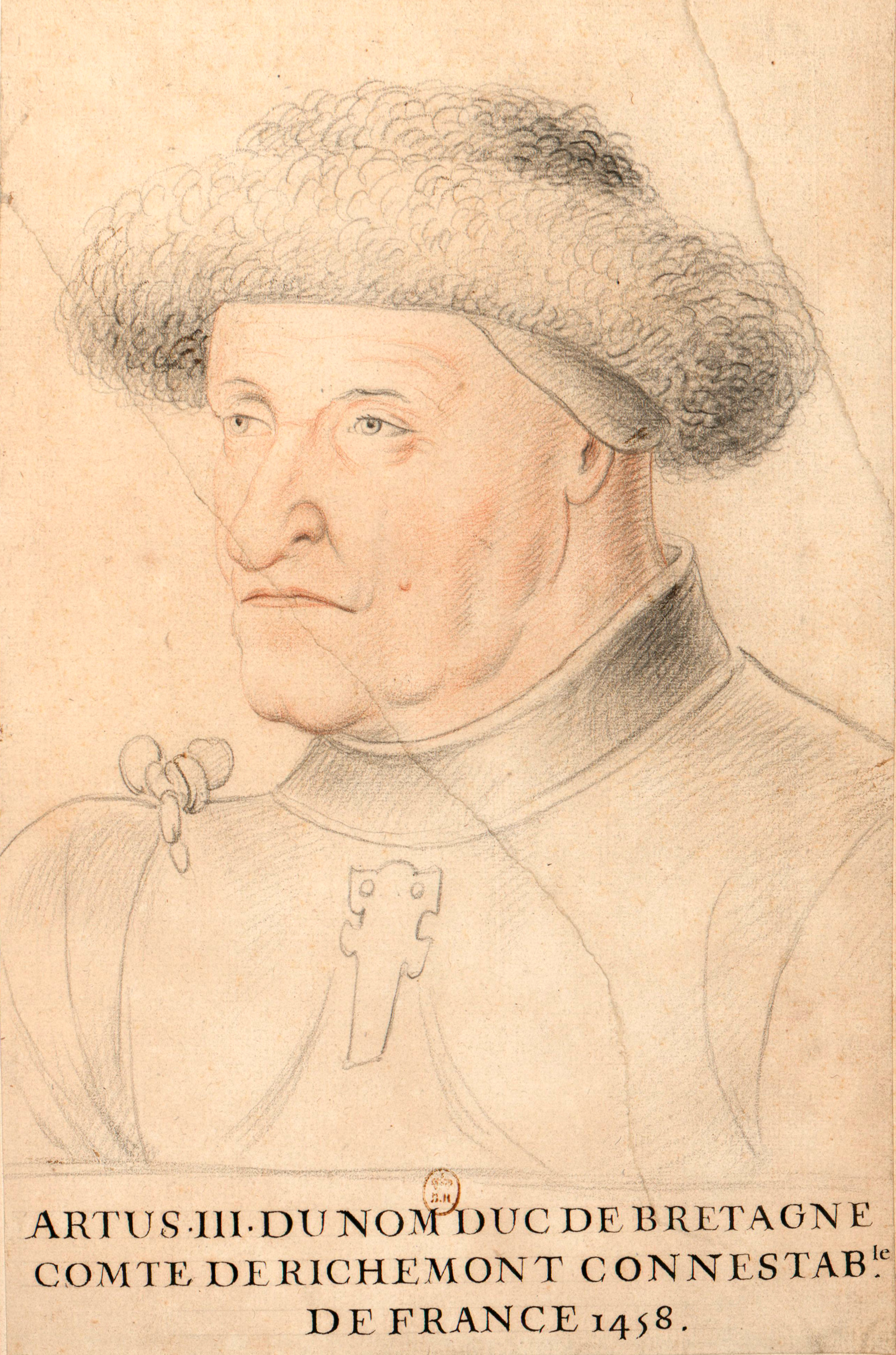 , 24 August 1393
, 24 August 1393
second son of John IV and
10 October 1423
no issue
(2)
Nérac
29 August 1442
no issue
(3) Catherine of Saint Pol
2 July 1445
no issue , 26 December 1458
Nantes
aged 65 , - , width=auto, Francis II
(''Frañsez II'')
1458–1488 , , 23 June 1433
, 23 June 1433
eldest son of Richard de Dreux, Count of Étampes and Marguerite d'Orléans, Countess of Vertus , (1) Marguerite of Brittany
Château de l'Hermine
16 November 1455
one son
(2) Marguerite of Foix
27 June 1474
two daughters , 9 September 1488
aged 55 , - , width=auto,
(''Anna'')
1488–1514 , , 25 January 1477
, 25 January 1477
eldest daughter of Francis II and Margaret of Foix , (1) ''
(by proxy)
19 December 1490
no issue
(2) Charles VIII of France
Château de Langeais
19 December 1491
four children
(3) Louis XII of France
8 January 1499
four children , 9 January 1514
Château de Blois
aged 36
(''Klaoda'')
1514–1524
''with
Francis
(1514–1515)'' ,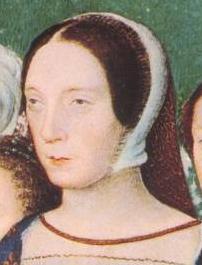 , 14 October 1499
, 14 October 1499
eldest daughter of Louis XII of France and
Château de Saint-Germain-en-Laye
18 May 1514
eight children , 20 July 1524
Château de Blois
aged 24 , - , width=auto, Francis
(''Frañsez'')
1514–1515
''with Claude
(1514–1515)'' ,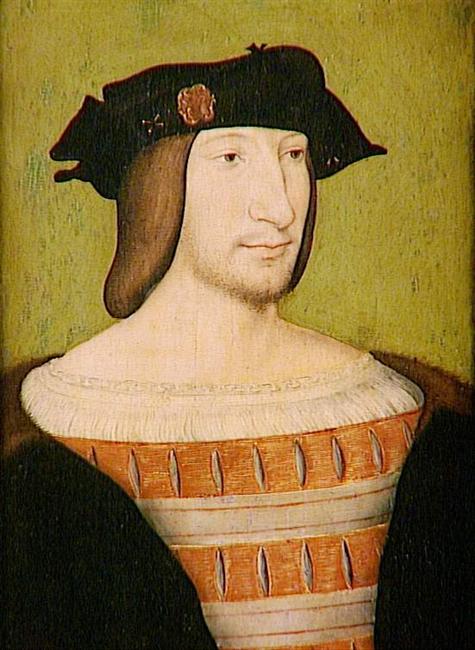 , 12 September 1494
, 12 September 1494
Château de Cognac
only son of Charles de Valois, Count of Angoulême and
Château de Saint-Germain-en-Laye
18 May 1514
eight children
(2) Eleanor of Austria
Abbaye de Veien
7 August 1530
no issue , 31 March 1547
Château de Rambouillet
aged 52 , - , width=auto, Francis III
(''Frañsez III'')
1524–1536 ,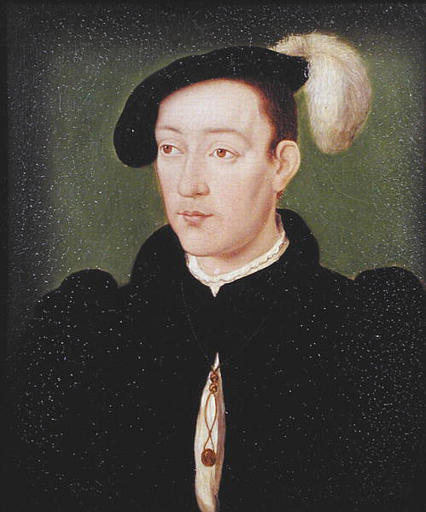 , 28 February 1518
, 28 February 1518
eldest son of
Chateau de Tournon
aged 18 , - , width=auto,
(''Herri'')
1536–1547 , , 31 March 1519
, 31 March 1519
Château de Saint-Germain-en-Laye
second son of
Marseille Cathedral
28 October 1533
ten children , 10 July 1559
Place des Vosges
aged 40 , -
1704–1705 , , 25 June 1704
, 25 June 1704
Palace of Versailles
eldest son of Louis, Duke of Burgundy and Marie-Adélaïde of Savoy , ''never married'' , 13 April 1705
Palace of Versailles
died before first birthday , - , width=auto, Louis de France
1707–1712 ,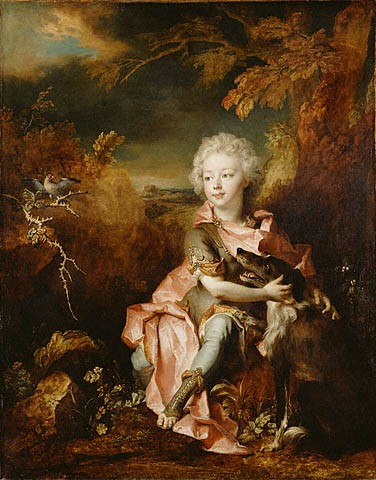 , 8 January 1707
, 8 January 1707
Palace of Versailles
second son of Louis, Duke of Burgundy and
Palace of Versailles
aged 5 , - , width=auto, Francis de Bourbon
1973–1984 , , 22 November 1972
, 22 November 1972
eldest son of
aged 11 , -
BRITTANY, Medieval Lands
{{Breton monarchs History of Brittany
Duchy of Brittany
The Duchy of Brittany ( br, Dugelezh Breizh, ; french: Duché de Bretagne) was a medieval feudal state that existed between approximately 939 and 1547. Its territory covered the northwestern peninsula of Europe, bordered by the Atlantic Ocean t ...
. In different epochs the sovereigns of Brittany
Brittany (; french: link=no, Bretagne ; br, Breizh, or ; Gallo: ''Bertaèyn'' ) is a peninsula, historical country and cultural area in the west of modern France, covering the western part of what was known as Armorica during the period ...
were kings, princes, and dukes. The Breton ruler was sometimes elected, sometimes attained the position by conquest or intrigue, or by hereditary right. Hereditary dukes were sometimes a female ruler, carrying the title duchesse of Brittany. Its principal cities and regions were ruled by counts who often found themselves in conflict with the Breton ruler, or who became the Breton ruler.
During the declining years of the Roman Empire
The Roman Empire ( la, Imperium Romanum ; grc-gre, Βασιλεία τῶν Ῥωμαίων, Basileía tôn Rhōmaíōn) was the post- Republican period of ancient Rome. As a polity, it included large territorial holdings around the Mediter ...
, the earliest Breton rulers in Gaul
Gaul ( la, Gallia) was a region of Western Europe first described by the Romans. It was inhabited by Celtic and Aquitani tribes, encompassing present-day France, Belgium, Luxembourg, most of Switzerland, parts of Northern Italy (only during ...
were styled "kings" of the small realms of Cornouaille
Cornouaille (; br, Kernev, Kerne) is a historical region on the west coast of Brittany in West France. The name is cognate with Cornwall in neighbouring Great Britain. This can be explained by the settlement of Cornouaille by migrant princ ...
and Domnonia. Some such kings may have had a form of hegemony over all of the Brythonic populations in the Armorica
Armorica or Aremorica (Gaulish: ; br, Arvorig, ) is the name given in ancient times to the part of Gaul between the Seine and the Loire that includes the Brittany Peninsula, extending inland to an indeterminate point and down the Atlantic Coast ...
n peninsula, and Riothamus
Riothamus (also spelled Riutimus or Riotimus) was a Romano-British military leader, who was active circa AD 470. He fought against the Goths in alliance with the declining Western Roman Empire. He is called " King of the Britons" by the 6th-century ...
is called King of the Britons by the chronicler Jordanes
Jordanes (), also written as Jordanis or Jornandes, was a 6th-century Eastern Roman bureaucrat widely believed to be of Gothic descent who became a historian later in life. Late in life he wrote two works, one on Roman history ('' Romana'') a ...
. However, there are no certain rulers of the whole of Brittany, which was divided into the fiefdoms of local counts.
The Duchy of Brittany had its origins in the Battle of Trans-la-Forêt of 939, which established the river Couesnon
The Couesnon (; br, Kouenon) is a river running from the ''département'' of Mayenne in north-western France, forming an estuary at Mont Saint-Michel. It is long, and its drainage basin is . Its final stretch forms the border between the histor ...
as the boundary between Brittany and Normandy. In 942, Alan II paid homage to Louis IV of France
Louis IV (September 920 / September 921 – 10 September 954), called ''d'Outremer'' or ''Transmarinus'' (both meaning "from overseas"), reigned as King of West Francia from 936 to 954. A member of the Carolingian dynasty, he was the only son of ...
; however, the duchy did not gain royal attention until 1123, when Louis VI of France confirmed the bishop of Nantes. No other Duke of Brittany repeated Alan II's homage until Arthur I
Arthur I ( br, Arzhur 1añ; french: link=no, Arthur 1er de Bretagne) (29 March 1187 – presumably 1203) was 4th Earl of Richmond and Duke of Brittany between 1196 and 1203. He was the posthumous son of Geoffrey II, Duke of Brittany, and Constan ...
recognised Philip II of France
Philip II (21 August 1165 – 14 July 1223), byname Philip Augustus (french: Philippe Auguste), was King of France from 1180 to 1223. His predecessors had been known as kings of the Franks, but from 1190 onward, Philip became the first French m ...
as his liege in 1202.
The area was often called a Duchy, and its rulers were considered independent Sovereign Dukes. However, one historical view is that before the middle of the 12th century the Dukes of Brittany were often also called Counts by the Kings of France, as the kingdom of France then saw Brittany as no more than a county. In 1297, the peninsula was elevated into a Duchy in the peerage of France
The Peerage of France (french: Pairie de France) was a hereditary distinction within the French nobility which appeared in 1180 in the Middle Ages.
The prestigious title and position of Peer of France (french: Pair de France, links=no) was ...
. This view is not consistent with the manner in which Charles VIII of France and then Louis XII of France approached the Duchy and the rights of Anne of Brittany who married each in succession.
Early Breton rulers
*Conan Meriadoc
Conan Meriadoc (; Welsh: Cynan Meriadog; Breton: Konan Meriadeg) is a legendary Celtic leader credited with founding Brittany. Versions of his story circulated in both Brittany and Great Britain from at least the early 12th century, and supplan ...
(4th century) – by tradition, the founder of Brittany
* Budic II (early 6th century)
*Waroch II
Waroch ( br, Gwereg) was an early Breton ruler of the Vannetais (').
Waroch, or his grandfather Waroch I, gave his name to the traditional Breton province of Bro-Waroch ("land of Waroch"). However, it is possible that there were several succe ...
(late 6th century)
* Saint Judicaël (early 7th century)
* Alain II Hir (640?–690)
* Morman ( 814–818)
* Wihomarc ( 822–825)
Dukes of Brittany
Dukes under the Carolingians
*Nominoe
Nominoe or Nomenoe (french: Nominoë; br, Nevenoe; c. 800, 7 March 851) was the first Duke of Brittany from 846 to his death. He is the Breton ''pater patriae'' and to Breton nationalists he is known as ' ("father of the country").
...
(or ''Nevenoe'') ( 841–851), as a '' missus dominicus'' of the Emperor
An emperor (from la, imperator, via fro, empereor) is a monarch, and usually the sovereignty, sovereign ruler of an empire or another type of imperial realm. Empress, the female equivalent, may indicate an emperor's wife (empress consort), ...
Louis the Pious
Louis the Pious (german: Ludwig der Fromme; french: Louis le Pieux; 16 April 778 – 20 June 840), also called the Fair, and the Debonaire, was King of the Franks and co-emperor with his father, Charlemagne, from 813. He was also King of Aqui ...
,Pierre Riche, ''The Carolingians: A family who forged Europe'', Transl. Michael Idomir Allen (University of Pennsylvania Press, 1993), 195. a count of Vannes (Gwened) and arguably a duke (''dux'') of Brittany
* Erispoe ( 851–857), as a duke, then as a king
* Salomon (or ''Salaun'') ( 857–874), as a duke, then a king
* Pasquitan (or ''Paskweten'') ( 874–877), ruling Brittany (southern part) with Gurvand
*Gurvand
Wrhwant, Gurwant, Gurwent or Gurvand ( la, Vurfandus) (died 876) was a claimant to the Kingdom of Brittany from 874 until his death in opposition to Pascweten, Count of Vannes.
Wrhwant was complicit in the conspiracy which assassinated Salomon i ...
( 874–877), ruling Brittany (northern part) with Pasquitan
* Judicael ( 877–888), successor of Gurvand, ruled Brittany (north) with Alan the Great (south)
* Alan the Great (reigned from 877 to 888 with Judicaël, alone as a duke, then as a king up to 907)
* Gourmaëlon, Count of Cornouaille
Cornouaille (; br, Kernev, Kerne) is a historical region on the west coast of Brittany in West France. The name is cognate with Cornwall in neighbouring Great Britain. This can be explained by the settlement of Cornouaille by migrant princ ...
(reigned from 907 as a guardian of the kingdom)
The succession was interrupted by the Viking
Vikings ; non, víkingr is the modern name given to seafaring people originally from Scandinavia (present-day Denmark, Norway and Sweden),
who from the late 8th to the late 11th centuries raided, pirated, traded and se ...
occupation (907–937)
House of Nantes
, width=auto, Alan IIthe Fox
(''Alan al Louarn'')
938–952 , , before 919
son of Mathuedoi, Count of Poher, and a daughter of Alan I , (1) Roscille of Anjou
943
(2) ? of Blois
bef. 949/51
one son , 952
Nantes
aged about 33 , - , width=auto, Drogo
(''Drogon'')
952–958 , , 949/52
only legitimate son of Alan II , ''never married'' , 958
Angers
Angers (, , ) is a city in western France, about southwest of Paris. It is the prefecture of the Maine-et-Loire department and was the capital of the province of Anjou until the French Revolution. The inhabitants of both the city and the pr ...
aged 5–9 , - , width=auto, Hoël I
(''Hoel Iañ '')
958–981 , , ?
illegitimate son of Alan II and the "noble" Judith , ''never married'' , 981
, - , width=auto, Guerech
(''Guerech Iañ'')
981–988 , , ?
illegitimate son of Alan II and the "noble" Judith, younger brother of Hoël I , Aremburga of Ancenis
after 981
one son , 988
, - , width=auto, Alan
(''Alan Breizh'')
988–990 , , after 981
son of Guerech and Aremburga of Ancenis , ''never married'' , 990 , -
House of Rennes
, width=auto, Conan I(''Konan Iañ'')
990–992 , , 927
eldest son of Judicael Berengar, Count of Rennes and Gerberga , Ermengarde-Gerberga of Anjou
973
five children , 27 June 992
Conquereuil
aged 64–65 , - , width=auto, Geoffrey I
(''Jafrez Iañ '')
992–1008 , , 980
eldest son of Conan I and Ermengarde-Gerberga of Anjou , Hawise of Normandy
996
four children , 20 November 1008
aged 27–28 , - , width=auto, Alan III
(''Alan III'')
1008–1040
''with Odo I as regent, then co-ruler (1008–1034)'' ,
eldest son of Geoffrey I and Hawise of Normandy , Bertha of Blois
1018
two children , 1 October 1040
Montgommery
aged 42–43 , - , width=auto, Odo I
(''Eozen I'')
1008–1034
''as regent, then co-ruler to Alan III'' ,
 , 999
, 999second son of Geoffrey I and Hawise of Normandy , Orguen of Cornouaille
six children , 1079
Cesson
Cesson () is a Communes of France, commune in the Seine-et-Marne Departments of France, department in the Île-de-France Regions of France, region in north-central France.
Demographics
The inhabitants are called ''Cessonnais''.
See also
*Commun ...
aged 79–80 , - , width=auto, Conan II
(''Konan II'')
1040–1066
''with Odo I as regent (1040–1057)'' , , 1033
only son of Alan III and Bertha of Blois , ''never married'' , 11 December 1066
Château-Gontier
Château-Gontier () is a former Communes of France, commune in the Mayenne Departments of France, department in north-western France. On 1 January 2019, it was merged into the new commune Château-Gontier-sur-Mayenne.
Geography
It is about sout ...
aged 32–33 , - , width=auto, Hawise
(''Hawiz'')
1066–1072
''with Hoël II '' , , 1037
only daughter of Alan III and Bertha of Blois , rowspan="2", 1066
seven children , 19 August 1072
aged 34–35 , - , width=auto, Hoël II
(''Hoël II'')
1066–1072
''with Hawise '' , , 1031
eldest son of Alain Canhiart, Count of Cornouaille and Judith of Nantes, descendant of Alan II , 13 April 1084
aged 52–53 , -
House of Cornouaille
, width=auto, Alan IVthe Younger
(''Alan IV Fergant '')
1072–1112
''with Hoël II as regent
(1072–1084)'' ,
 , bef. 1060
, bef. 1060eldest son of Hoël II and Hawise , (1)
Constance of Normandy
Constance of Normandy (between 1057 and 1061 – 13 August 1090) was a Duchess of Brittany.
She was one of the nine children of William the Conqueror and Matilda of Flanders. She was born in Normandy, where her father was duke. William of Jumiè ...
1086/88
no issue
(2) Ermengarde of Anjou
1093
three children , 13 October 1119
Redon Abbey
aged 60s , - , width=auto, Conan III
the Fat
(''Konan III'')
1112–1148 ,
eldest son of Alan IV and Ermengarde of Anjou , Maud FitzRoy
1112
three children , 17 September 1148
aged 54–58 , - , width=auto,
Bertha
Bertha is a female Germanic name, from Old High German ''berhta'' meaning "bright one". It was usually a short form of Anglo Saxon names ''Beorhtgifu'' meaning "bright gift" or ''Beorhtwynn'' meaning "bright joy".
The name occurs as a theonym, s ...
(''Berta'')
1148–1156
''with Odo II '' ,
eldest daughter of Conan III and Maud FitzRoy , (1) Alan, 1st Earl of Richmond
1137/8
three children
(2) Odo II
1148
three children , 1156
aged 41–43 , - , width=auto, Odo II
(''Eozen II'')
1148–1156
''with
Bertha
Bertha is a female Germanic name, from Old High German ''berhta'' meaning "bright one". It was usually a short form of Anglo Saxon names ''Beorhtgifu'' meaning "bright gift" or ''Beorhtwynn'' meaning "bright joy".
The name occurs as a theonym, s ...
''
, eldest son of Geoffrey, Viscount of Porhoet and Hawise , (1)
Bertha
Bertha is a female Germanic name, from Old High German ''berhta'' meaning "bright one". It was usually a short form of Anglo Saxon names ''Beorhtgifu'' meaning "bright gift" or ''Beorhtwynn'' meaning "bright joy".
The name occurs as a theonym, s ...
1148
three children
(2) Joan-Eleanor of Léon
August 1167
two or three children , 1170
, -
(''Konan IV'')
1156–1166 ,
 , 1138
, 1138only son of Alan of Penthièvre, 1st Earl of Richmond and
Bertha
Bertha is a female Germanic name, from Old High German ''berhta'' meaning "bright one". It was usually a short form of Anglo Saxon names ''Beorhtgifu'' meaning "bright gift" or ''Beorhtwynn'' meaning "bright joy".
The name occurs as a theonym, s ...
, Margaret of Huntingdon1160
one daughter , 20 February 1171
aged 33 , - , width=auto, Constance
(''Konstanza'')
1166–1201
''with Geoffrey II
(1181–1186)
with
Arthur I
Arthur I ( br, Arzhur 1añ; french: link=no, Arthur 1er de Bretagne) (29 March 1187 – presumably 1203) was 4th Earl of Richmond and Duke of Brittany between 1196 and 1203. He was the posthumous son of Geoffrey II, Duke of Brittany, and Constan ...
(1196–1201)
with Guy
(1199–1201)'' ,
daughter of Conan IV and Margaret of Huntingdon , (1) Geoffrey II
July 1181
three children
(2) Ranulf
3 February 1188
no issue
(3)
Guy of Thouars
Guy of Thouars (died 13 April 1213) was the third husband of Constance, Duchess of Brittany, whom he married in Angers, County of Anjou between August and October 1199 after her son Arthur of Brittany entered Angers to be recognized as count of ...
October 1199
two or three daughters , 5 September 1201
Nantes
aged 40 , - , width=auto, Geoffrey II
(''Jafrez II'')
1181–1186
''with Constance '' ,
 , 23 September 1158
, 23 September 1158fourth son of
Henry II of England
Henry II (5 March 1133 – 6 July 1189), also known as Henry Curtmantle (french: link=no, Court-manteau), Henry FitzEmpress, or Henry Plantagenet, was King of England from 1154 until his death in 1189, and as such, was the first Angevin king ...
and Eleanor of Aquitaine
Eleanor ( – 1 April 1204; french: Aliénor d'Aquitaine, ) was Queen of France from 1137 to 1152 as the wife of King Louis VII, Queen of England from 1154 to 1189 as the wife of King Henry II, and Duchess of Aquitaine in her own right from 1 ...
, ConstanceJuly 1181
three children , 19 August 1186
Paris, France
aged 27 , - , width=auto, Guy
(''Gi'')
1199–1201
1203–1213''
with Constance
(1199–1201)
with Alix
(1203–1213)'' , , birth date unknown
second son of
Aimery IV of Thouars
Aimery IV viscount of Thouars ( 1024 – c. 1094) was a companion of William the Conqueror on his Invasion of England in 1066.
Life
He was the son of Geoffrey II of Thouars, and Agnes de Blois, daughter of Odo I, Count of Blois and Bertha ...
and Aénor of Lusignan
, (1) ConstanceOctober 1199
two or three daughters
(2) Eustachie of Chemillé
1203
two sons , 13 April 1213
Chemillé, France , -
Arthur I
Arthur I ( br, Arzhur 1añ; french: link=no, Arthur 1er de Bretagne) (29 March 1187 – presumably 1203) was 4th Earl of Richmond and Duke of Brittany between 1196 and 1203. He was the posthumous son of Geoffrey II, Duke of Brittany, and Constan ...
(''Arzhur Iañ'')
1196–1203
''with Constance
(1196–1201)'' ,
 , 29 March 1187
, 29 March 1187in Nantes,
only son of Geoffrey II and Constance , never married , Disappeared in captivity aged 16; fate unknown , -
Eleanor, Fair Maid of Brittany
Eleanor, Fair Maid of Brittany (c. 1184 – 10 August 1241), also known as Damsel of Brittany, Pearl of Brittany, or Beauty of Brittany, was the eldest daughter of Geoffrey II, Duke of Brittany, and Constance, Duchess of Brittany. Her father, ...
, eldest daughter of Geoffrey and Constance and full elder sister of Arthur, also unmarried, was prevented from succession for her imprisonment in England which lasted till her death in 1241, thus was merely a titular duchess until 1214 when John, King of England ceased to support her claim.
House of Thouars
, width=auto, Alix(''Alis'')
1203–1221
''with Guy as regent
(1203–1213)
with Peter I
(1213–1221)'' ,
 , 1200
, 1200eldest daughter of Guy and Constance , Peter I
1213
three children , 21 October 1221
aged 21 , - , width=auto, Peter I
Mauclerc
(''Pêr Iañ'')
1213–1221
''with Alix'' ,
 , 1190
, 1190second son of Robert II of Dreux and
Yolanda de Coucy
Yolanda may refer to:
* Yolanda (name), a given name derived from the Greek ''Iolanthe''
Places
* Yolanda, California
* Yolanda Shrine, monument located at Barangay Anibong, Tacloban, Leyte
Film
* ''Yolanda'' (film), a 1924 film starring ...
, (1) Alix1213
three children
(2) Nicole
1230
one son
(3)
Marguerite de Commequiers Marguerite may refer to:
People
* Marguerite (given name), including a list of people with the name
Places
*Marguerite, Pennsylvania, an unincorporated community
*Marguerite Bay, Antarctic Peninsula
* Marguerite Island, Adélie Land, Antarctica ...
bef. January 1236
no issue , 6 July 1250
sea off
Damietta
Damietta ( arz, دمياط ' ; cop, ⲧⲁⲙⲓⲁϯ, Tamiati) is a port city and the capital of the Damietta Governorate in Egypt, a former bishopric and present multiple Catholic titular see. It is located at the Damietta branch, an easter ...
aged 59–60 , -
the Red
(''Yann Iañ ar Ruz'')
1221–1286
''with Peter I as regent
(1221–1237)'' ,
 , 1217/18
, 1217/18eldest son of Peter I and Alix , Blanche of Navarre
Château-Thierry, Aisne
16 January 1236
eight children , 8 October 1286
Château de l'Isle, Férel,
Morbihan
Morbihan ( , ; br, Mor-Bihan ) is a department in the administrative region of Brittany, situated in the northwest of France. It is named after the Morbihan (''small sea'' in Breton), the enclosed sea that is the principal feature of the coastl ...
aged 67–69 , - , width=auto, John II
(''Yann II'')
1286–1305 ,
 , 3/4 January 1239
, 3/4 January 1239eldest son of John I and Blanche of Navarre , Beatrice of England
Westminster Abbey
Westminster Abbey, formally titled the Collegiate Church of Saint Peter at Westminster, is an historic, mainly Gothic church in the City of Westminster, London, England, just to the west of the Palace of Westminster. It is one of the Unite ...
, London25 December 1260
eight children , 16 November 1305
Lyon
Lyon,, ; Occitan language, Occitan: ''Lion'', hist. ''Lionés'' also spelled in English as Lyons, is the List of communes in France with over 20,000 inhabitants, third-largest city and Urban area (France), second-largest metropolitan area of F ...
aged 66 , - , width=auto, Arthur II
(''Arzhur II'')
1305–1312 ,
 , 2 July 1262
, 2 July 1262eldest son of John II and Beatrice of England , (1) Marie of Limoges
Tours
Tours ( , ) is one of the largest cities in the region of Centre-Val de Loire, France. It is the prefecture of the department of Indre-et-Loire. The commune of Tours had 136,463 inhabitants as of 2018 while the population of the whole metro ...
1277
three children
(2) Yolande of Dreux
May 1292
six children , 27 August 1312
Château de l'Isle, Férel,
Morbihan
Morbihan ( , ; br, Mor-Bihan ) is a department in the administrative region of Brittany, situated in the northwest of France. It is named after the Morbihan (''small sea'' in Breton), the enclosed sea that is the principal feature of the coastl ...
aged 50 , - , width=auto, John III
the Good
(''Yann III'')
1312–1341 ,
 , 8 March 1286
, 8 March 1286Château de Champtoceaux, Maine-et-Loire
eldest son of Arthur II and Marie of Limoges , (1)
Isabella of Valois
Isabella of France (9 November 1389 – 13 September 1409) was Queen of England as the wife of Richard II, King of England between 1396 and 1399, and Duchess (consort) of Orléans as the wife of Charles, Duke of Orléans from 1406 until her ...
18 February 1298
no issue
(2) Isabella of Castile and León
Burgos
Burgos () is a city in Spain located in the autonomous community of Castile and León. It is the capital and most populated municipality of the province of Burgos.
Burgos is situated in the north of the Iberian Peninsula, on the confluence of ...
21 June 1310
no issue
(3) Joan of Savoy
Chartres
21 March 1330
no issue , 30 April 1341
Caen
aged 55
Breton War of Succession
The War of the Breton Succession (, ) was a conflict between the Counts of Blois and the Montforts of Brittany for control of the Sovereign Duchy of Brittany, then a fief of the Kingdom of France. It was fought between 1341 and 12 April 1 ...
, width=auto, Joanthe Lame
(''Janed'')
1341–1364
''with Charles I '' ,
 , 1319
, 1319only daughter of Guy of Brittany, Count of Penthièvre and Joan of Avaugour , rowspan="2", Paris
4 June 1337
five children , 10 September 1384
Guingamp
Guingamp (; ) is a commune in the Côtes-d'Armor department in Brittany in northwestern France. With a population of 6,895 as of 2017, Guingamp is one of the smallest towns in Europe to have a top-tier professional football team: En Avant Gui ...
aged 64–65 , - , width=auto, Charles I
(''Charlez Iañ'')
1341–1364
''with Joan '' ,
 , 1319
, 1319Blois
Blois ( ; ) is a commune and the capital city of Loir-et-Cher department, in Centre-Val de Loire, France, on the banks of the lower Loire river between Orléans and Tours.
With 45,898 inhabitants by 2019, Blois is the most populated city of the ...
second son of Guy I, Count of Blois and
Margaret of Valois
Margaret of Valois (french: Marguerite, 14 May 1553 – 27 March 1615), popularly known as La Reine Margot, was a French princess of the Valois dynasty who became Queen of Navarre by marriage to Henry III of Navarre and then also Queen of France ...
, 29 September 1364Auray
aged 44–45 , - , width=auto, John (IV) of Montfort
(''Yann IV Moñforzh'')
May 1341–1345 ,
 , 1293
, 1293only son of Arthur II and Yolande de Dreux , Joanna of Flanders
Chartres
March 1329
two children , 26 September 1345
Château d'Hennebon,
Hennebont
Hennebont (; ) is a commune in the Morbihan department in the region of Brittany in north-western France.
Geography
Hennebont is situated about ten miles from the mouth of the River Blavet, which divides it into two parts: the ''Ville Close'' ...
aged 51–52 , - , width=auto, John (V) of Montfort
(''Yann V Moñforzh'')
1345–1364 ,
 , 1339
, 1339only son of John of Montfort and Joanna of Flanders , (1) Mary Plantagenet of England
Woodstock Palace
Woodstock Palace was a royal residence in the English town of Woodstock, Oxfordshire.
Henry I of England built a hunting lodge here and in 1129 he built of walls to create the first enclosed park, where lions and leopards were kept. The lodge b ...
, Woodstock, Oxfordshiresummer of 1361
no issue
(2) Joan Holland
London
May 1366
no issue
(3)
Joan of Navarre Joan of Navarre may refer to:
*Joan I of Navarre (1273–1305), daughter of Henry I of Navarre
*Joan II of Navarre (1312–1349), daughter of Louis I of Navarre
* Joan of Navarre (nun) (1326–1387), daughter of Joan II of Navarre and Philip III of ...
Saillé-près-Guérande
2 October 1386
nine children , 1/2 November 1399
Nantes
aged 59–60
House of Montfort
House of Montfort was a medieval French noble house that eventually found its way to the Kingdom of England and originated the famous Simon de Montfort, 6th Earl of Leicester; although his father Simon de Monfort the Elder, leader of the French ...
, width=auto, John IVthe Conqueror
(''Yann IV'')
1364–1399
(Previously ''John V'' in pretentious succession from his father.) ,
 , 1339
, 1339only son of John of Montfort and Joanna of Flanders , (1) Mary Plantagenet of England
Woodstock Palace
Woodstock Palace was a royal residence in the English town of Woodstock, Oxfordshire.
Henry I of England built a hunting lodge here and in 1129 he built of walls to create the first enclosed park, where lions and leopards were kept. The lodge b ...
, Woodstock, Oxfordshiresummer of 1361
no issue
(2) Joan Holland
London
May 1366
no issue
(3)
Joan of Navarre Joan of Navarre may refer to:
*Joan I of Navarre (1273–1305), daughter of Henry I of Navarre
*Joan II of Navarre (1312–1349), daughter of Louis I of Navarre
* Joan of Navarre (nun) (1326–1387), daughter of Joan II of Navarre and Philip III of ...
Saillé-près-Guérande
2 October 1386
nine children , 1/2 November 1399
Nantes
aged 59–60 , - , width=auto, John V
the Wise
(''Yann V ar Fur'')
1399–1442 ,
 , 24 December 1389
, 24 December 1389Château de l'Hermine, Vannes,
Morbihan
Morbihan ( , ; br, Mor-Bihan ) is a department in the administrative region of Brittany, situated in the northwest of France. It is named after the Morbihan (''small sea'' in Breton), the enclosed sea that is the principal feature of the coastl ...
eldest son of John IV and
Joan of Navarre Joan of Navarre may refer to:
*Joan I of Navarre (1273–1305), daughter of Henry I of Navarre
*Joan II of Navarre (1312–1349), daughter of Louis I of Navarre
* Joan of Navarre (nun) (1326–1387), daughter of Joan II of Navarre and Philip III of ...
, Joan of FranceHôtel de Saint-Pol, Paris
19 September 1396
seven children , 29 August 1442
Manoir de La Touche, Nantes
aged 52 , - , width=auto, Francis I
the Well-Loved
(''Frañsez Iañ'')
1442–1450 ,
 , 11 May 1414
, 11 May 1414Vannes
eldest son of John V and Joan of France , (1) Yolande of Anjou
Amboise
20 August 1431
one son
(2) Isabella of Scotland
Château d'Auray
30 October 1442
two daughter , 17 July 1450
Château de l'Hermine, Vannes,
Morbihan
Morbihan ( , ; br, Mor-Bihan ) is a department in the administrative region of Brittany, situated in the northwest of France. It is named after the Morbihan (''small sea'' in Breton), the enclosed sea that is the principal feature of the coastl ...
aged 36 , - , width=auto, Peter II
the Simple
(''Pêr II'')
1450–1457 ,
 , 7 July 1418
, 7 July 1418Nantes
second son of John V and Joan of France , Françoise d'Amboise
1442
no issue , 22 September 1457
Nantes
aged 41 , - , width=auto, Arthur III
the Justicier
(''Arzhur III'')
1457–1458 ,
 , 24 August 1393
, 24 August 1393Château de Suscinio
The Château de Suscinio or de Susinio is a Breton castle, built in the late Middle Ages, to be the residence of the Dukes of Brittany. It is located in the commune of Sarzeau in the département of Morbihan, near the coast of the Atlantic ocean. ...
, Vannessecond son of John IV and
Joan of Navarre Joan of Navarre may refer to:
*Joan I of Navarre (1273–1305), daughter of Henry I of Navarre
*Joan II of Navarre (1312–1349), daughter of Louis I of Navarre
* Joan of Navarre (nun) (1326–1387), daughter of Joan II of Navarre and Philip III of ...
, (1) Margaret of BurgundyDijon
Dijon (, , ) (dated)
* it, Digione
* la, Diviō or
* lmo, Digion is the prefecture of the Côte-d'Or department and of the Bourgogne-Franche-Comté region in northeastern France. the commune had a population of 156,920.
The earlies ...
10 October 1423
no issue
(2)
Jeanne d'Albret
Jeanne d'Albret ( Basque: ''Joana Albretekoa''; Occitan: ''Joana de Labrit''; 16 November 1528 – 9 June 1572), also known as Jeanne III, was Queen of Navarre from 1555 to 1572.
Jeanne was the daughter of Henry II of Navarre and Margar ...
Nérac
29 August 1442
no issue
(3) Catherine of Saint Pol
2 July 1445
no issue , 26 December 1458
Nantes
aged 65 , - , width=auto, Francis II
(''Frañsez II'')
1458–1488 ,
 , 23 June 1433
, 23 June 1433Château de Clisson
The Château de Clisson is a castle in the '' commune'' of Clisson in the Loire-Atlantique ''département'' of France. It stands on the right bank of the Sèvre Nantaise.
History
Within then independent Brittany, the castle, situated at a cross ...
eldest son of Richard de Dreux, Count of Étampes and Marguerite d'Orléans, Countess of Vertus , (1) Marguerite of Brittany
Château de l'Hermine
16 November 1455
one son
(2) Marguerite of Foix
Château de Clisson
The Château de Clisson is a castle in the '' commune'' of Clisson in the Loire-Atlantique ''département'' of France. It stands on the right bank of the Sèvre Nantaise.
History
Within then independent Brittany, the castle, situated at a cross ...
27 June 1474
two daughters , 9 September 1488
Couëron
Couëron (; ) is a commune in the Loire-Atlantique department in western France. It is part of the historic French Brittany.
Couëron is one of the 24 communes of the Nantes Métropole.
Geography
Physical geography
Couëron is located 10 m ...
aged 55 , - , width=auto,
Anne
Anne, alternatively spelled Ann, is a form of the Latin female given name Anna. This in turn is a representation of the Hebrew Hannah, which means 'favour' or 'grace'. Related names include Annie.
Anne is sometimes used as a male name in the ...
(''Anna'')
1488–1514 ,
 , 25 January 1477
, 25 January 1477Château de Nantes
A château (; plural: châteaux) is a manor house or residence of the lord of the manor, or a fine country house of nobility or gentry, with or without fortifications, originally, and still most frequently, in French-speaking regions.
Nowaday ...
eldest daughter of Francis II and Margaret of Foix , (1) ''
Maximilian I, Holy Roman Emperor
Maximilian I (22 March 1459 – 12 January 1519) was King of the Romans from 1486 and Holy Roman Emperor from 1508 until his death. He was never crowned by the pope, as the journey to Rome was blocked by the Venetians. He proclaimed himself E ...
''(by proxy)
Rennes Cathedral
Rennes Cathedral (french: Cathédrale Saint-Pierre de Rennes) is a Roman Catholic church located in the town of Rennes, France. It has been a monument historique since 1906.
The cathedral, dedicated to Saint Peter, is the seat of the Archbishop ...
19 December 1490
no issue
(2) Charles VIII of France
Château de Langeais
19 December 1491
four children
(3) Louis XII of France
Château de Nantes
A château (; plural: châteaux) is a manor house or residence of the lord of the manor, or a fine country house of nobility or gentry, with or without fortifications, originally, and still most frequently, in French-speaking regions.
Nowaday ...
8 January 1499
four children , 9 January 1514
Château de Blois
aged 36
House of Valois
The Capetian house of Valois ( , also , ) was a cadet branch of the Capetian dynasty. They succeeded the House of Capet (or "Direct Capetians") to the French throne, and were the royal house of France from 1328 to 1589. Junior members of the f ...
, width=auto, Claude(''Klaoda'')
1514–1524
''with
Francis
(1514–1515)'' ,
Romorantin-Lanthenay
Romorantin-Lanthenay (), commonly known as Romorantin, is a commune and town in the Loir-et-Cher department, administrative region of Centre-Val de Loire, France.
It is the capital city of the natural region of Sologne.
History
The current ...
eldest daughter of Louis XII of France and
Anne
Anne, alternatively spelled Ann, is a form of the Latin female given name Anna. This in turn is a representation of the Hebrew Hannah, which means 'favour' or 'grace'. Related names include Annie.
Anne is sometimes used as a male name in the ...
, Francis I of France
Francis I (french: François Ier; frm, Francoys; 12 September 1494 – 31 March 1547) was King of France from 1515 until his death in 1547. He was the son of Charles, Count of Angoulême, and Louise of Savoy. He succeeded his first cousin on ...
Château de Saint-Germain-en-Laye
18 May 1514
eight children , 20 July 1524
Château de Blois
aged 24 , - , width=auto, Francis
(''Frañsez'')
1514–1515
''with Claude
(1514–1515)'' ,
 , 12 September 1494
, 12 September 1494Château de Cognac
only son of Charles de Valois, Count of Angoulême and
Louise of Savoy
Louise of Savoy (11 September 1476 – 22 September 1531) was a French noble and regent, Duchess ''suo jure'' of Auvergne and Bourbon, Duchess of Nemours, and the mother of King Francis I. She was politically active and served as the regent of F ...
, (1) ClaudeChâteau de Saint-Germain-en-Laye
18 May 1514
eight children
(2) Eleanor of Austria
Abbaye de Veien
7 August 1530
no issue , 31 March 1547
Château de Rambouillet
aged 52 , - , width=auto, Francis III
(''Frañsez III'')
1524–1536 ,
 , 28 February 1518
, 28 February 1518Château d'Amboise
The Château d'Amboise is a château in Amboise, located in the Indre-et-Loire ''département'' of the Loire Valley in France. Confiscated by the monarchy in the 15th century, it became a favoured royal residence and was extensively rebuilt. K ...
eldest son of
Francis I of France
Francis I (french: François Ier; frm, Francoys; 12 September 1494 – 31 March 1547) was King of France from 1515 until his death in 1547. He was the son of Charles, Count of Angoulême, and Louise of Savoy. He succeeded his first cousin on ...
and Claude
, ''never married''
, 10 August 1536Chateau de Tournon
aged 18 , - , width=auto,
Henry
Henry may refer to:
People
*Henry (given name)
* Henry (surname)
* Henry Lau, Canadian singer and musician who performs under the mononym Henry
Royalty
* Portuguese royalty
** King-Cardinal Henry, King of Portugal
** Henry, Count of Portugal, ...
(''Herri'')
1536–1547 ,
 , 31 March 1519
, 31 March 1519Château de Saint-Germain-en-Laye
second son of
Francis I of France
Francis I (french: François Ier; frm, Francoys; 12 September 1494 – 31 March 1547) was King of France from 1515 until his death in 1547. He was the son of Charles, Count of Angoulême, and Louise of Savoy. He succeeded his first cousin on ...
and Claude
, Catherine de' MediciMarseille Cathedral
28 October 1533
ten children , 10 July 1559
Place des Vosges
aged 40 , -
As courtesy title
, width=auto, Louis de France1704–1705 ,
Palace of Versailles
eldest son of Louis, Duke of Burgundy and Marie-Adélaïde of Savoy , ''never married'' , 13 April 1705
Palace of Versailles
died before first birthday , - , width=auto, Louis de France
1707–1712 ,
 , 8 January 1707
, 8 January 1707Palace of Versailles
second son of Louis, Duke of Burgundy and
Marie Adélaïde of Savoy
Marie Adélaïde of Savoy (6 December 1685 – 12 February 1712) was the wife of Louis, Dauphin of France, Duke of Burgundy. She was the eldest daughter of Victor Amadeus II, Duke of Savoy, and of Anne Marie d'Orléans. Her betrothal to the Duk ...
, ''never married''
, 18 February 1712Palace of Versailles
aged 5 , - , width=auto, Francis de Bourbon
1973–1984 ,
Madrid
Madrid ( , ) is the capital and most populous city of Spain. The city has almost 3.4 million inhabitants and a Madrid metropolitan area, metropolitan area population of approximately 6.7 million. It is the Largest cities of the Europ ...
eldest son of
Alfonso, Duke of Anjou and Cádiz
Alfonso, Duke of Anjou, Duke of Cádiz, Grandee of Spain (''Alfonso Jaime Marcelino Manuel Víctor María de Borbón y Dampierre'', French citizen as ''Alphonse de Bourbon''; 20 April 1936 – 30 January 1989) was a grandson of King Alfonso XIII ...
and María del Carmen Martínez-Bordiú y Franco
, ''never married''
, 7 February 1984Pamplona
Pamplona (; eu, Iruña or ), historically also known as Pampeluna in English, is the capital city of the Chartered Community of Navarre, in Spain. It is also the third-largest city in the greater Basque cultural region.
Lying at near above ...
aged 11 , -
Family tree
See also
*Brittany
Brittany (; french: link=no, Bretagne ; br, Breizh, or ; Gallo: ''Bertaèyn'' ) is a peninsula, historical country and cultural area in the west of modern France, covering the western part of what was known as Armorica during the period ...
* Château des ducs de Bretagne (Castle of the Dukes of Brittany)
* Duchy of Brittany
The Duchy of Brittany ( br, Dugelezh Breizh, ; french: Duché de Bretagne) was a medieval feudal state that existed between approximately 939 and 1547. Its territory covered the northwestern peninsula of Europe, bordered by the Atlantic Ocean t ...
* List of Breton royal consorts
* Union of Brittany and France
The union of Brittany and France was a critical step in the formation of modern-day France. Brittany had been a semi-independent component of the Kingdom of France since Clovis I was given authority over the Gallo-Roman domain during the 5th ce ...
References
External links
BRITTANY, Medieval Lands
{{Breton monarchs History of Brittany
Brittany
Brittany (; french: link=no, Bretagne ; br, Breizh, or ; Gallo: ''Bertaèyn'' ) is a peninsula, historical country and cultural area in the west of modern France, covering the western part of what was known as Armorica during the period ...